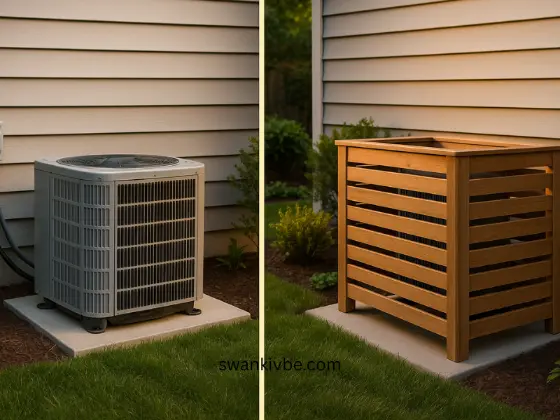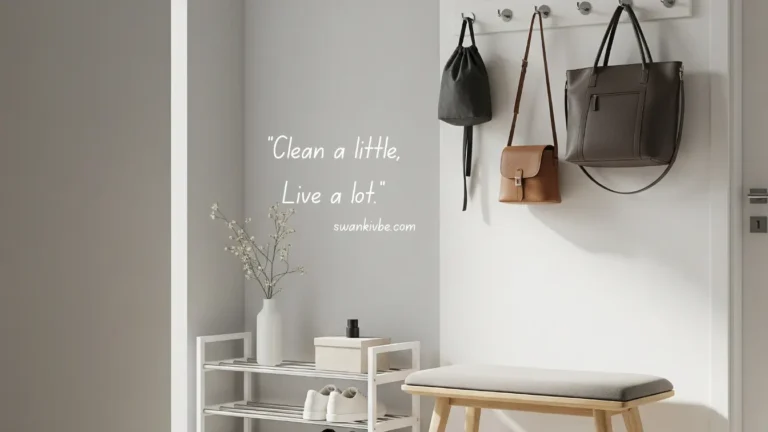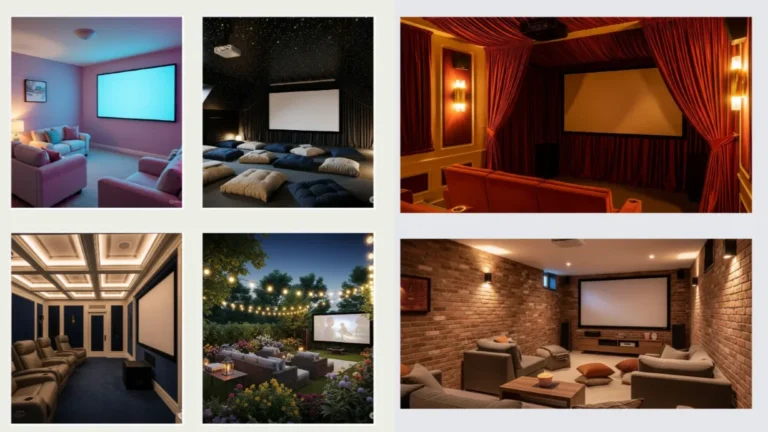
How to Hide AC Unit (Indoor and Outdoor) Smart & Stylish Ideas
AC units are essential, especially in hot climates—but they aren’t exactly attractive. Whether it’s a bulky outdoor condenser or a wall-mounted indoor split AC, these machines can clash with your home’s aesthetics.
Thankfully, hiding them doesn’t mean you have to compromise airflow or safety. With the right design choices, you can blend your AC units seamlessly into your décor and landscape.
This guide covers practical, creative, and budget-friendly solutions to hide both indoor and outdoor AC units. From wooden fences to indoor cabinets, we’ll explore options that work for different spaces, budgets, and climates. Plus, we’ll share helpful tips on what to avoid so you don’t affect your unit’s performance. Read on to learn how to hide your AC units without damaging their function or safety.

2. Why Hiding Your AC Unit Matters
Hiding your AC unit isn’t just about looks—there are many practical reasons to consider it.
First, a concealed AC system instantly improves your home’s exterior or interior aesthetic. Whether you’re planning to sell your property or just want a cleaner, modern vibe, a hidden AC unit makes a big difference.
Second, screens or covers can provide protection from debris, sunlight, and weather elements, which can help extend the life of your unit.
Third, it adds a layer of safety, especially if you have children or pets that might tamper with the equipment. According to HomeAdvisor, a well-landscaped and well-designed outdoor area (including hidden utility items) can increase property value by up to 12 percent. Just make sure your cover or enclosure still allows for adequate ventilation and easy access for maintenance.

3. Best Ways to Hide Outdoor AC Units
a. Wooden Fence or Lattice Enclosure
A wooden enclosure is one of the most popular and durable ways to hide your outdoor AC unit. A lattice-style design is ideal because it provides proper airflow while still blocking the unit from sight. You can either build one yourself or purchase pre-made screens from a home improvement store.
For maintenance, make sure the enclosure is openable or removable. Experts recommend leaving at least 30 cm, or 12 inches, of space between the AC and the enclosure for proper ventilation. Paint or stain the wood to match your exterior for a cohesive look. This not only boosts curb appeal but can also protect the unit from debris and harmful UV rays.

b. Decorative Metal or PVC Screens
Decorative metal or PVC screens offer a modern alternative to wooden fencing. These are easy to install and come in stylish patterns like geometric, floral, or minimalist grids. You can choose materials like powder-coated aluminum, which is both durable and weather-resistant.
PVC is a more affordable option that’s also water-resistant and lightweight. Make sure the screen is freestanding or mounted in a way that doesn’t block ventilation. The open design helps keep airflow intact, while still making the unit less visible. Many homeowners use metal screens as a double-duty feature — they hide the AC and also act as a design element in their landscaping.

c. Green Plants or Shrubs
Greenery is a natural and attractive way to hide your AC unit while blending it with the landscape. Plants like boxwood, bamboo, or ornamental grasses grow quickly and provide excellent coverage.
This method also has the added benefit of providing shade to the AC unit, which can improve its efficiency. However, it’s essential to keep plants trimmed and maintain a 30 cm gap around the unit to ensure proper airflow. You can also place plants in raised planters or decorative pots if you want flexibility or live in a rented home. Just ensure the roots or leaves don’t interfere with the AC fan or coils.

d. Vertical Garden Wall
For those short on space or who want a trendy look, a vertical garden is a perfect solution. You can create one using wooden pallets, wire frames, or vertical planters. Add herbs, flowers, or decorative plants that partially cover the AC unit while maintaining airflow.
This not only disguises the machine but also creates a fresh and eco-friendly vibe in your outdoor space. Make sure you position the garden wall so that it doesn’t touch the AC or limit access to it. Vertical gardens also offer flexibility — you can easily remove or change the plants seasonally for a refreshed look.

e. Custom-Built Stone or Brick Wall
If you’re going for a high-end and permanent solution, a stone or brick wall can be built around the AC unit. It should be at least two-sided, allowing one side to remain open for airflow and maintenance access. Use matching stone or bricks to blend it with your home’s exterior or garden path.
While this option is more expensive, it’s extremely durable and weather-resistant. You can also add a small gate or access panel for service visits. If space allows, you might also include landscaping elements like planters on top or around the structure for extra charm.

**Image Idea:**
Brick wall enclosure around an outdoor AC unit with garden flowers.
**Alt text:** Custom brick enclosure with airflow gap built around a backyard AC condenser.
4. Best Ways to Hide Indoor AC Units
a. Floating Shelves Around the Unit
Floating shelves offer a clever way to disguise wall-mounted indoor AC units. By installing shelves above or around the AC, you turn it into part of the room’s design. Place decorative items like books, plants, or photo frames on the shelves to draw attention away from the unit itself.
This works especially well in living rooms, bedrooms, or study areas. Just remember to leave enough space above and around the AC so that airflow isn’t restricted. Don’t put any heavy items directly above the vents, and clean the area regularly to avoid dust buildup.

b. Wall Cabinet or Cover Box
A custom cabinet is a perfect solution for those who want to hide their indoor AC unit completely when it’s not in use. These cabinets can be made with louvered or slatted doors, which allow air to flow even when closed. For a minimalist look, match the cabinet design to your wall color or furniture.
You can build it from MDF, plywood, or buy a readymade cover box online. Just make sure it’s not a sealed box—ventilation is key. These cabinets are ideal for bedrooms or study areas where you want a cleaner, sleeker interior look.

c. Artistic Screen or Divider
An artistic screen or room divider is a quick and stylish way to hide a split AC unit, especially in bedrooms or open-plan living rooms. Choose a folding screen made from rattan, wood, or fabric with a cut-out pattern that allows ventilation.
Not only does it hide the unit, but it can also serve as a decor accent. You can even use photo panels, mirrors, or artwork-based screens for a personalized touch. These screens are especially useful if you don’t want to install anything permanently or if you’re renting the space.

d. Curtains or Sliding Panels
If you’re looking for a flexible and stylish method, ceiling-mounted curtains or sliding panels are an excellent option. When the AC is not in use, simply draw the curtain or panel to hide it.
When needed, slide it back to allow proper cooling. This technique is popular in bedrooms and living rooms with ceiling-mounted or high wall units. Choose light fabrics like linen or sheers that blend well with your room’s theme. Be sure to use materials that won’t obstruct airflow or hang directly over the AC vents.

5. Safety & Maintenance Tips
While hiding your AC units, don’t forget that airflow, access, and safety are critical. Never block the intake or exhaust completely, as it can lead to overheating or system damage. According to Energy.gov, improper airflow can reduce your AC’s efficiency by 15–20%, leading to higher energy bills and shortened lifespan.
Use breathable materials like lattice, slats, or open-pattern screens. Always leave at least 30 cm (12 inches) of space around outdoor units, and don’t place any cover directly on top of an indoor unit’s vent. Lastly, make sure service technicians can easily access the unit for regular maintenance and cleaning. A well-hidden unit should still be easy to use and service.

6. Mistakes to Avoid
While it’s tempting to fully cover your AC for aesthetic reasons, several common mistakes can lead to serious issues. Avoid fully enclosing the unit with sealed or solid materials, as it prevents ventilation and may overheat the motor. Never use flammable materials like fabric or cardboard that can pose a fire risk.
Avoid blocking the drainage pipe or covering exhaust vents. Also, steer clear of using adhesive decorations or heavy objects that could fall and damage the unit. Ensure your cover solution allows quick access for filter cleaning and maintenance. A good rule of thumb is: if a human technician can’t access it easily, it’s a bad design.

7. Budget-Friendly DIY Ideas
Budget-Friendly DIY Ideas to Hide Your AC Unit
You don’t need to spend a lot of money to make your AC unit look better. With a little creativity and basic materials, you can hide it in style while keeping things safe and functional. Here are some easy and affordable DIY ideas anyone can try:
- Pallet Wood Screen: Old wooden pallets can be turned into a rustic screen. Just clean them up, screw them together in an L or U shape, and place them around your outdoor unit. It’s budget-friendly and gives a cozy, handmade touch.
- PVC Pipe & Curtain Frame: For indoor units, build a simple frame using PVC pipes and hang a light curtain over it. You can match the fabric to your room decor. This is perfect for renters because it’s easy to set up and remove.
- Folding Decorative Screens: These are great for both indoor and outdoor use. You can find them online for under $50. Just place them in front of the unit—no tools or installation needed.
- Contact Paper with Faux Finish: If your AC unit is visible on the wall, use removable contact paper that looks like wood, marble, or concrete. It helps the unit blend with your décor and is easy to peel off when needed.
- Painted Cardboard Cover (Temporary): For special occasions or short-term needs, paint a cardboard box and cut airflow holes. Place it around the unit for a cleaner look during gatherings or events.
Important Tip: No matter which idea you choose, always leave enough space for airflow and easy access for maintenance. Proper ventilation keeps your AC running safely and efficiently.
8. Conclusion
Your AC units may not be pretty—but they don’t have to be an eyesore either. With the right hiding technique, you can enhance your home’s look without sacrificing performance or safety. From vertical gardens and wooden fences outside to artistic screens and floating shelves inside, there’s a solution for every space and budget.
Always consider airflow, safety, and maintenance access before finalizing your design. Whether you’re upgrading for resale value or personal comfort, a well-hidden AC can bring both function and beauty to your living space.
References
Lowe’s – DIY Air Conditioner Covers
Step-by-step tutorials for building DIY AC covers using easy-to-find materials.
HomeAdvisor – How Landscaping Affects Home Value
Learn how smart landscaping, including hiding AC units, can boost your home’s resale value.
Energy.gov – Air Conditioner Maintenance Tips
Official guidance from the U.S. Department of Energy on keeping your AC running efficiently and safely.
HGTV – Creative Ways to Hide AC Units
Explore stylish and practical ideas to blend your AC unit with your outdoor decor.
If you found this blog helpful, you’ll definitely enjoy more home and lifestyle ideas we’ve shared just for you.
How to Keep Your Home Always Clean – 15 Proven Daily Tips
20 Stylish Small Home Theater Ideas That Feel Like a Private Cinema





